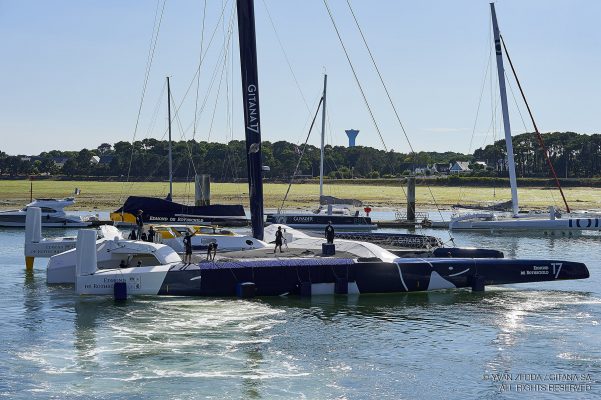The most radical of the new Ultime trimarans, the incredible Gitana 17 is designed to foil at over 50 knots and cross up to 900 miles a day, crewed by just one solo skipper. Elaine Bunting talked to designer Guillaume Verdier at the launch
A revolutionary 100ft fully foiling oceangoing trimaran capable of covering more than 900 miles in a day and sailing at speeds of 50 knots was launched in Lorient this week. Designed by Guillaume Verdier, the foil genius behind the America’s Cup winning Emirates Team New Zealand, Gitana 17 is designed to be sailed solo and to beat the round the world record.
Gitana 17 is the latest of the race boats backed by Baron Benjamin de Rothschild. The 100ft ‘Ultime’ trimaran is the culmination of three years of work by the team and brings together developments from areas as diverse as the Vendée Globe IMOCA 60s, the America’s Cup and the MOD70 trimarans.
This is a beast of a boat and significantly different from others in the growing ‘Ultime’ development class such as François Gabart’s Macif and Thomas Coville’s Sodebo. For the first time, this is a boat designed around foil performance.
According to the design team, Gitana 17 will be able to foil at speeds of 48-50 knots in 16-25 knots of true wind and seas of 6-8m – typical Atlantic conditions. It could also sail across the Southern Ocean in non-foiling mode at up to 40 knots.
“Foiling is not that [hard] but to do that and be stable in waves is a lot more difficult and this is a first stage to doing that,” explained Guillaume Verdier. “Previously the boats were designed to go offshore and slowly the foils got into that, but we have designed the appendages as a principal [part] and tried to have a platform that goes well with that.
“It makes a boat that is a little heavier because there are more systems to control the foil, more hydraulics and the platform is stiffer in torsion.”

Launched on 17 July from Multiplast, Gitana 17 is the new Ultime class built for Baron Edmond de Rothschild.
The foils on Gitana 17 share some common thinking with those on the America’s Cup boats – the outer float foils are an L-shape. The main daggerboard on the central hull, however, is a shape never seen before on these boats and features a large horizontal component to help with roll control.
The concepts were evolved through 2014 and 2015 on Gitana 15, the MOD70 now known as Giovanni Soldini’s Maserati. The team fitted one hull with several foil shapes to understand their performance offshore. “One of the issues we had was that it was fairly unstable, rolling-wise, and an elevator on the stern [alone] would not be enough for singlehanded control. So we introduced this element, which is draggy but will help a lot,” explained Verdier.
The T-foil rudders on the outer hulls are an ingenious and complex solution and designed by the Gitana team. They feature elevators to adjust trim and are operated by hydraulic system monitored by electronic software. But they can also kick up if they collide with something in the water, and be raised out of the water.
The windward rudder is very exposed to slamming from waves when reaching, so can be lifted up, locked into the hull and disconnected from the control systems. A large housing that you can see in the photo below protects the rudder and controls.

Gitana 17 has the mast stepped in Lorient
Verdier says that these rudder foils are “a bit like the AC72 foils; they are auto-stable”.
He explained: “They behave a bit like a helicoil. When the boat raises up in the water it makes more leeway, and when it makes more leeway there is a component of the force that pushes you down. But the difference [with the America’s Cup boats] is that this is a huge foil compared to any other boat in the past.”

The 100ft Gitana 17 is designed to foil trans-ocean solo
According to Verdier, Gitana 17 could one day foil at more than 50 knots. “But when foiling we are limited by cavitation, so if wanted to go above that we’d need to have different profiles and aerodynamic aspects, and structure of the boat. It’s a bit of an unknown territory, but maybe we should be able to do 53 or 54 knots.”
The main aim of the designers, however, is to improve the boat’s average high speed potential, and Verdier says that Gitana 17 could reach 900 miles in 24 hours – the much bigger fully crewed 130ft catamaran Banque Populaire V holds the record of 908 miles. This could be an ultimate record-breaker, though the quiet-spoken French designer hesitates to say so. “I could pick any crazy number,” he smiles. “It’s pretentious to say. We have to wait a little.”




